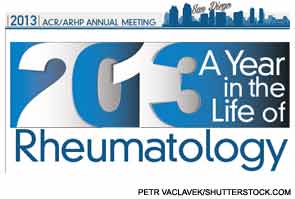
SAN DIEGO—Although the past year failed to deliver any new drugs for rheumatic diseases, several new indications for existing drugs have emerged over the past year that are particularly exciting for pediatric diseases. In addition, the year has shown that achieving major results in clinical trials requires the effort of large collaborative networks. On the basic-science front, new information continues to emerge on specific disease mechanisms and pathophysiology of various rheumatologic diseases that hold promise for a future of personalized medicine and truly targeting treatment for each patient. These were some of the key points discussed during a “Year in Review” session here at the 2013 ACR/ARHP Annual Meeting, held October 26–30. [Editor’s Note: This session was recorded and is available via ACR SessionSelect at www.rheumatology.org.]
Clinical Perspective: Keeping an Open Mind
Bringing participants up to date on the latest clinical news, David Wofsy, MD, professor of medicine and microbiology and immunology at the University of California, San Francisco, emphasized the need for rheumatologists to keep an open mind. “Several of the key studies this year challenged conventional wisdom,” he said. “They may not change preconceived notions or eliminate skepticism by themselves, but they remind us to keep an open mind.”
Among these is a study by Katz and colleagues that looked at surgery versus physical therapy for meniscal tear and osteoarthritis.1 The study included 351 patients older than 45 years with symptomatic mild to moderate osteoarthritis with a meniscal tear, randomized to arthroscopic partial meniscectomy plus physical therapy or physical therapy alone with an opportunity to switch to surgery if physical therapy was not satisfactory. Based on the difference in standard physical function after six months, the study found comparable improvement based on the Western Ontario and McMaster Universities Osteoarthritis Index (WOMAC) score between the two groups. According to Dr. Wofsy, 70% of patients did not require surgery and did exactly as well as the patients initially randomized to surgical therapy. “This suggests that roughly 70% of patients can do without surgery,” he said.
He did note that, in the study, 30% of the patients in the physical therapy group eventually underwent surgery by six months due to persistent symptoms. “The outcome in these patients at 12 months,” he said, “was also comparable to those who underwent surgery initially.”
Despite some limitations of the trial that may include selection bias, he thinks the trial results are valid and that physical therapy should be considered an option for these patients.
He also highlighted two other studies in adults regarding the treatment of active rheumatoid arthritis (RA), each of which offers important data on challenging questions on the management of RA patients. He noted results of the study by O’Dell and colleagues that showed for the first time the noninferiority of triple therapy compared to etanercept plus methotrexate (MTX) for patients with active RA who don’t respond to MTX alone.2
According to Chester V. Oddis, MD, professor of medicine and associate director of the rheumatology fellowship training program at the Arthritis Institute in Pittsburgh, who moderated the session, this study offers convincing data that triple therapy produces similar outcomes to biologics, in particular, anti–tumor necrosis factor therapy. “Not only is this an important area from a practice perspective, but it is very important economically, and when payers see this and react to it, then this could greatly affect our choice of treatments for RA,” he said.
Another clinical question that is on the minds of many rheumatologists and was addressed in a 2013 published study, said Dr. Wofsy, is whether there is a window of opportunity in early poor prognosis RA that warrants immediate combination therapy. He briefly described a post-hoc analysis of the TEAR trial by O’Dell, Moreland, and colleagues that looked at this a question by randomizing 755 patients with active early RA to immediate combination therapy, MTX plus step up to combination therapy at 24 weeks, or MTX monotherapy.3 At 102 weeks, the study showed comparable clinical and radiographic outcomes between patients treated with initial MTX monotherapy with the option to step up to combination therapy and those treated with initial combination therapy.
Finally, he briefly described a longer follow-up study by Specks and colleagues on remission-inducing regimens for antineutrophil cytoplasmic antibody (ANCA)–associated vasculitis.4 The study included 197 patients with severe, organ-threatening ANCA-associated vasculitis randomized to rituximab followed by placebo or cyclophosphamide followed by azathioprine. A 2010 report at six months showed that rituximab was noninferior at six months and superior for relapsing disease. In this updated study, rituximab continued to show noninferiority and superiority at 12 and 18 months. Dr. Wofsy emphasized the importance of the long-term efficacy and sustained response with rituximab shown in the study, as well as the great collaboration among researchers that addressed this challenging problem.
Along with highlighting some of the key studies in adults, he briefly summarized study data on five drugs with new indications—three of which are for pediatrics (See Table 1).
He emphasized again that these studies, particularly the pediatrics trials, show what can be achieved with large collaborative networks working together on these challenging questions. “With very few exceptions, the work that I highlight [in this session] required collaboration and trust among many investigators,” he said. “Very little of this work could have been accomplished at a single site or even a small handful of sites.”
Basic Science Perspective: Moving Toward Personalized Medicine
Steven R. Goldring, MD, chief scientific officer and St. Giles Chair of the Hospital for Special Surgery and professor of medicine at Weill Cornell Medical College in New York, N.Y., touched on several areas of research over the past year that are helping to further refine an understanding of the disease mechanisms and pathophysiology of rheumatic diseases. Among this research is ongoing inquiry into identifying new molecules and pathways that hold promise for developing more effective and specific therapies for rheumatic diseases. He cited a number of studies looking at targeting the interleukin 23 pathway for treatment of ankylosing spondylitis and psoriatic arthritis, the use of lubricin to slow the progression of osteoarthritis, and targeting the Wnt pathway for treatment of fibrosing disorders such as scleroderma.5-7
These studies show what can be achieved with large collaborative networks working together.
He also talked about the huge databases generated by two parallel collaborative projects, ENCODE and the NIH Roadmap Epigenomics Mapping Consortium, and the daunting task of applying the information from these databases to understanding disease mechanisms and biological and clinical processes. He highlighted examples of recent studies that are already beginning to address these needs, such as, “a study that has identified a generic variant (SNP) that controls the level of disease activity in rheumatoid arthritis and Crohn’s disease, and a study that has identified the potential role of epigenetic modifications in DNA structure in the pathogenesis and activation of disease flares in patients with systemic lupus.” 8,9
Dr. Goldring emphasized that information from the genomic and epigenetic studies is beginning to provide important insights into disease mechanisms and pathophysiology. “These insights also hold the promise of providing biomarkers that can be used to direct patient care, predict outcomes, and provide insights into disease mechanisms that can be used to select optimal patient treatments,” he said.
Mary Beth Nierengarten is a freelance medical journalist based in St. Paul, Minn.
References
- Katz JN, Brophy RH, Chaisson CE, et al. Surgery versus physical therapy for a meniscal tear and osteoarthritis. N Engl J Med. 2013; 368:1675-1684.
- O’Dell JR, Mikuls TR, Taylor TH, et al. Therapies for active rheumatoid arthritis after methotrexate failure. N Engl J Med. 2013;369:307-318.
- O’Dell JR, Curtis JR, Mikuls TR, et al. Validation of the methotrexate-first strategy in patients with early, poor-prognosis rheumatoid arthritis: Results from a two-year randomized, double-blind trial. Arthritis Rheum. 2013;65:1985-1994.
- Specks U, Merkel PA, Seo P, et al. Efficacy of remission-induction regimens for ANCA-associated vasculitis. N Engl J Med. 2013;369:417-427.
- Sherlock JP, Joyce-Shaikh B, Turner SP, et al. IL-23 induces spondyloarthropathy by acting on ROR-γt+ CD3+CD4-CD8- entheseal resident T cells. Nat Med. 2012;18:1069-1076.
- Ruan MZ, Erez A, Guse K, et al. Proteoglycan 4 expression protects against the development of osteoarthritis. Sci Transl Med. 2013;5:176ra34.
- Akhmetshina A, Palumbo K, Dees C, et al. Activation of canonical Wnt signalling is required for TGF-β-mediated fibrosis. Nat Commun. 2012;3:735.
- Lee JC, Espéli M, Anderson CA, et al. Human SNP Links Differential Outcomes in Inflammatory and Infectious Disease to a FOXO3-Regulated Pathway. Cell. 2013; 155:57-69.
- Absher DM, Li X, Waite LL, et al. Genome-wide DNA methylation analysis of systemic lupus erythematosus reveals persistent hypomethylation of interferon genes and compositional changes to CD4+ T-cell populations. PLoS Genetics. 2013;9:e1003678.



